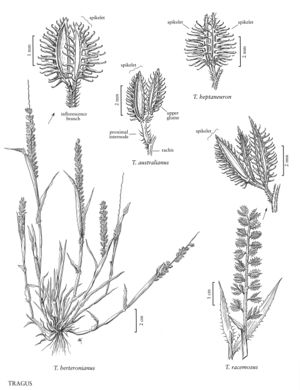Tragus racemosus
Plants annual. Culms 5-40 cm. Ligules 0.5-1.3 mm; blades (0.5)1-5.5 cm long, 1.5-4 mm wide, glabrous. Panicles (1.5)2-11 cm long, 7-13 mm wide; rachises pubescent; branches 2.1-4.8 mm, pubescent, with (2)3-5 spikelets, axes extending past the distal spikelets; proximal internodes 0.5-1.8 mm, longer than second internodes. Proximal spikelets 3.8-6.6 mm; second spikelets (2.3)2.9-6.6 mm; third and fourth spikelets 0.8-4.2 mm; distal spikelets sterile. Lower glumes 0.7-1.1 mm, glabrous or minutely pubescent; upper glumes 3.8-6.6 mm, 7-veined, minutely pubescent; glume projections 6-11, in (5)6-7 rows, (0.2)0.6-1.3 mm, usually uncinate; lemmas 3.2-4 mm, sparsely pubescent on the back, midveins occasionally excurrent to 4 mm; paleas 2.3-3.1 mm; anthers 3, 0.6-0.8 mm, yellow. Caryopses 1.7-2.3 mm long, 0.6-0.8 mm wide. 2n = 40.
Distribution
Maine, Md., N.J., N.Y., Mass., N.C., Pa., Ariz.
Discussion
Tragus racemosus is native from the Mediterranean region to southwest Asia, but now grows in the United States, primarily in Cochise and Pima Counties, Arizona. It was collected in Maine, Pennsylvania, New York, and North Carolina in the late nineteenth century, but does not appear to be established in these states. Reports for New Mexico and Texas appear to reflect confusion with T. berteronianus.
Selected References
None.
